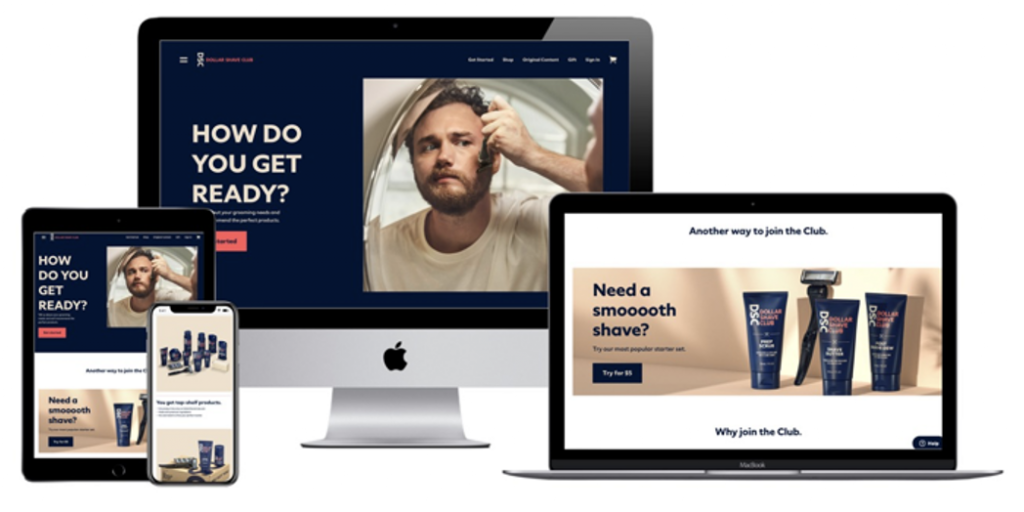Contents
Or read the White Paper below ...
E-commerce subscriptions are on the increase. They’re not just for more “traditional” niches like newspapers, tv, etc. Nowadays, companies in fashion, lifestyle, and FMCG industries are successfully adopting this model.
According to data collected by McKinsey in 2018, the largest subscription-based companies generated $2.6 billion in 2016 (as compared to only $57 million in 2011).
This huge increase can be attributed to the fact that nearly half of all consumers have hopped on to some subscription service bandwagon. As of 2019 more than a quarter of Brits were signed up for a subscription model.
An eCommerce subscription model is a business model in which a company provides ongoing services on a regular basis in exchange for regular payments from the customer.
The reason why this model is becoming increasingly popular with eCommerce merchants is the high customer retention ratio combined with the greater business predictability.
E-commerce subscriptions likewise help brands increase repeat purchases. You have a 60-70% chance of selling to an existing customer, versus a 5-20% chance of selling to a new prospect.

The above images show a variety of companies rolling out subscriptions across a number of verticals, some of which would not necessarily be obvious candidates for subscriptions such as fashion clothing and leisure.
There are three main types of subscription models: Replenishment, Curation or Access.
Replenishment model
Replenishment subscriptions focus on convenience with recurring deliveries of consumable products – e.g. Bloom & Wild, Gousto and HP Instant Ink.
Curation model
Curation subscriptions are collections of products delivered to individual recipients based on their unique needs and tastes - e.g. Stitch Fix and Birchbox. They look to surprise and delight.
Access model
Access subscriptions are member-only programs that cater to “VIP” perks, early access to new products, and exclusivity. Customers must purchase a membership in order to have access to the company’s services/products – e.g. Amazon Prime, Naked Wines, Ocado Smartpass, etc.
Consumers don’t subscribe to products because they enjoy spending money. So why do so many buyers subscribe to products?
Exploration: with so much choice online, many buyers see subscriptions as a simple way to “try something new” that’s highly personalised.
Personalisation: one of the main factors in the longevity of a subscription is increased personalisation over time—this is something to keep in mind to minimise churn.
Value: overall price is not the key factor here, but rather value for money; as one of the key reasons why someone subscribes and churns, it’s important to manage expectations with your buyers.
Consumer buying habits are trending toward hassle-free shopping experiences, free delivery and instant gratification. The subscription model serves all those needs, providing value to the customer with low effort and incredible growth opportunities for subscription-based businesses.

Increased retention
The longer your customer is subscribed, the more you will learn about their preferences and the better you will be able to meet their needs/desires.
Improved forecasting
Traditional online retail is based on ad hoc purchasing and total revenues, whereas subscription models rely on pre-planned purchasing and recurring revenue. The value of a subscription is in this recurring, predictable revenue.
You will be able to better predict revenues and profits but also make more informed predictions regarding what products you need in stock and how much staffing you will need to fulfil.
More engagement
Subscribers will expect you to contact them more often and will be more receptive to your communications because it’s in their interest to do so.
Better customer relationship management
Subscriptions turn customers, who already see the value your company provides, into loyal followers who become reliable sources of recurring revenue. In fact, the longer a customer uses your product or service, the more valuable they become to you. Plus, higher customer retention rates mean lower acquisition costs in the long term.
Differentiation: In a highly commoditized or saturated industry, like beauty, a subscription offering can set your brand apart and establishes you as a curator or influencer in your space.
Segmentation: With more information on subscription customers than a typical checkout, there is greater opportunity for upsells or cross-sells as well as to “surprise and delight”.
Stability: As subscriptions take root, you can more accurately predict inventory levels, reduce waste and cultivate recurring revenue.
Decide who your target customers are
Are you going to offer subscriptions to existing customers or a whole new demographic? What information do you have about them? Are they subscribed to any other services already?
Find out what’s lacking/missing
What improvements or changes are they looking to make in their lives? Do they want to have more fun, improve their health, improve their home, etc?
Define what makes you different
What are your competitors not doing that you can do to address these needs/wants? Do you offer faster delivery, are your products ethically sourced, do you support charities, do you have vegan, gluten free options etc?
Consider gifting
Don’t just think about what people will want/need for themselves, think about whether they might want to purchase your products and services for someone else. What better gift for a loved one than a subscription to a product or service that they love? Bloom & Wild allow their customers to purchase a regular delivery of flowers for a loved one, all conveniently delivered to their door.
Choose the right platform
Add a service to your existing website or create a new offering – whatever you do, it needs to be omnichannel and accessible. It may be that subscriptions can be easily added to your existing site if you have one. Alternatively you may need to rethink how you do eCommerce and fulfilment as a whole and as a result it may be more cost effective to replatform.
Would your customers prefer a mobile-first approach, like an app, or would they prefer to manage their subscriptions from their desktop? The answer is both so make sure that you choose a platform that will allow you to deliver an excellent user experience across all devices. Consider implementing a Progressive Web App (PWA) as this will allow you to cater for all of your customers needs and desires through one single platform.
For more information on PWAs, go here.
No points of difference
Can they already get it elsewhere? For example, what are the differences between Gousto and Hello Fresh? They both sell regular deliveries of recipe boxes right? There are however differences between the two offerings. For example Gousto offers a wider choice of dietary preferences whilst Hello Fresh appear to put more emphasis on sustainability with their packaging.
Subscription fatigue
49% of consumers are using at least 1 subscription service at any one time – don’t rest on your laurels and make sure that you continue to engage and delight your subscribers or someone else will. Think about expanding/improving your service over time based on customer feedback.
Is it easy for your customers to manage their subscriptions?
What happens if a customer needs to update their payment info because their card has expired? What if they need to go away for a while? Can they pause their subscriptions? What if you don’t have what they have subscribed for that week? Can you offer an alternative or process a refund? What if they need to change the frequency?
Make sure you have the right technology and skills on hand to cater for all of the above eventualities as you will quickly loose customers if you don’t.
Cancellation
More than one-third of consumers cancel their subscription in less than three months, and more than half cancel within six months. So efforts to reduce churn and keep customers are crucial. Understand why they are cancelling. Maybe they just want to take a break? Provide incentives for them not to cancel like discounts and promotions during the cancellation process.
Pricing
Ensure you tie the pricing and model to your business goals (increased revenue, reduced cost of acquisition, increase AOV, etc.) and measure.
You don’t need to be the cheapest if you are offering a better service than your competitors but you do need to make sure that you deliver on that promise and it comes at a cost and that needs to be factored in to your pricing model.
Customers are happy to pay more for items if they can get them faster but don’t like to pay for delivery so bear that in mind when pricing your goods/services.
Renewals
Incentivise advanced payment and auto-renewals as this will allow you to better predict your revenues and also please your customers.
Take an omnichannel approach
The more positive experiences you provide your subscribers across all devices and in store, the better your chances of keeping them on board. It’s no good offering subscriptions online if they cannot also manage them in store. They will expect you to have a joined up approach and one single view of customer, so think about what platforms and solutions you can use to deliver on this expectation.
Consider loyalty
Using a loyalty program, you can customise your subscription model to include perks and benefits.
Many of the successful eCommerce subscription models function when companies are committed to treating existing customers with care and encourage them to stay in long term spending cycles.
Make sure you focus on these two themes – loyalty and convenience – when exploring a subscription business model for your company.
Make sure that your fulfilment is super slick
How you deliver to your customer is super important. They will be the first to cancel their subscriptions if the goods don’t arrive on time or arrive damaged or incomplete in some way, especially if the goods you are providing are necessities for their everyday lives. Make sure you choose the right fulfilment partners and platforms.
The Dollar Shave Club was a revolutionary subscriptions idea launched in 2012 in a saturated market for men’s shaving. It consisted of a simple value proposition, that was affordable and convenient with universal appeal.

Part of the success was down to the game changing marketing which showed consumers how subscribing would provide them with a unique, fun experience that they could share with their friends and colleagues. The company was valued at $615 million in 2015, now has 1.1 million subscribers and was recently acquired for $1 billion cash by Unilever.
The opportunity for growing and improving your business through subscriptions is huge but the opportunity to upset your customers is equally large if you don’t do it right.
Consider a soft launch first so you can test the service and products you are offering. Make sure you do your research and choose the right agency with the right experience and technical expertise to guide you through.
And finally, listen to your customers, learn from them and be prepared to respond to rapidly changing market needs.
For expert advice, call us on +44 1932 359160 or email [email protected]


